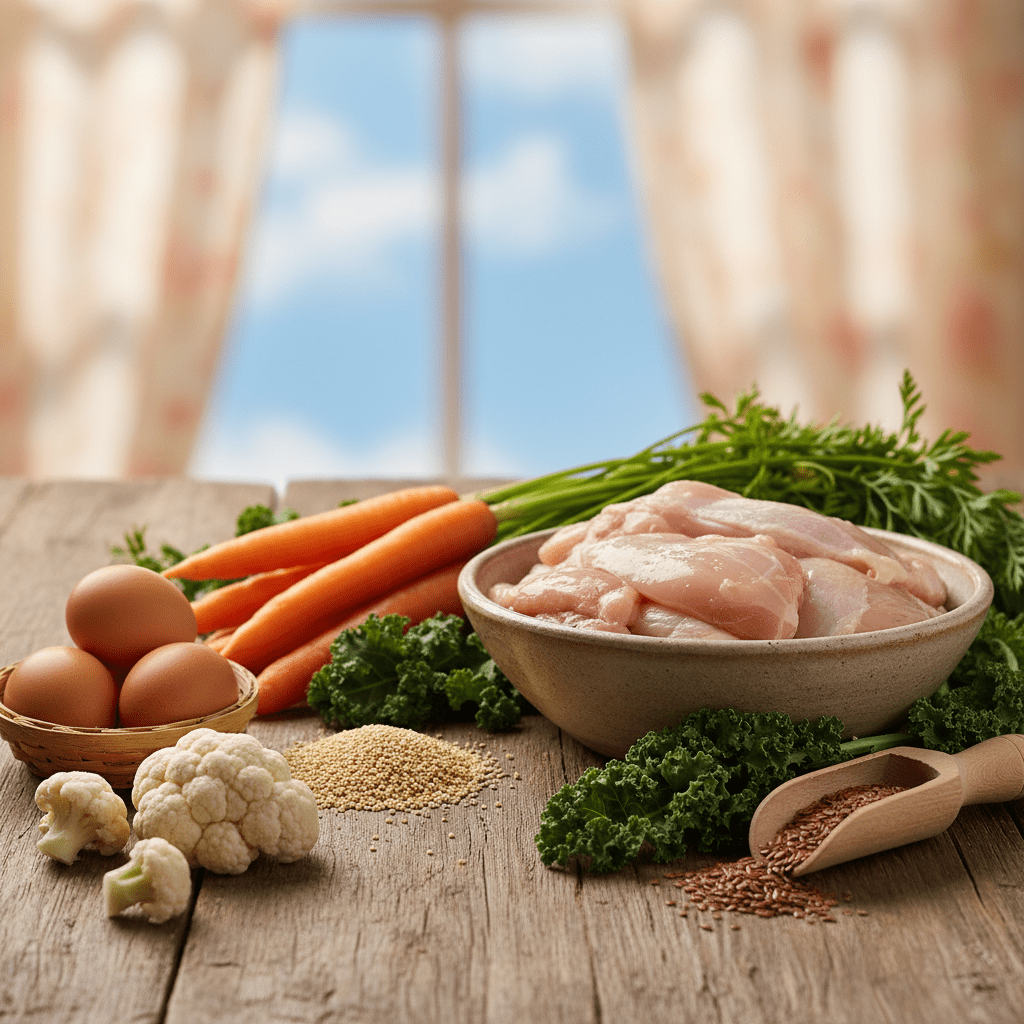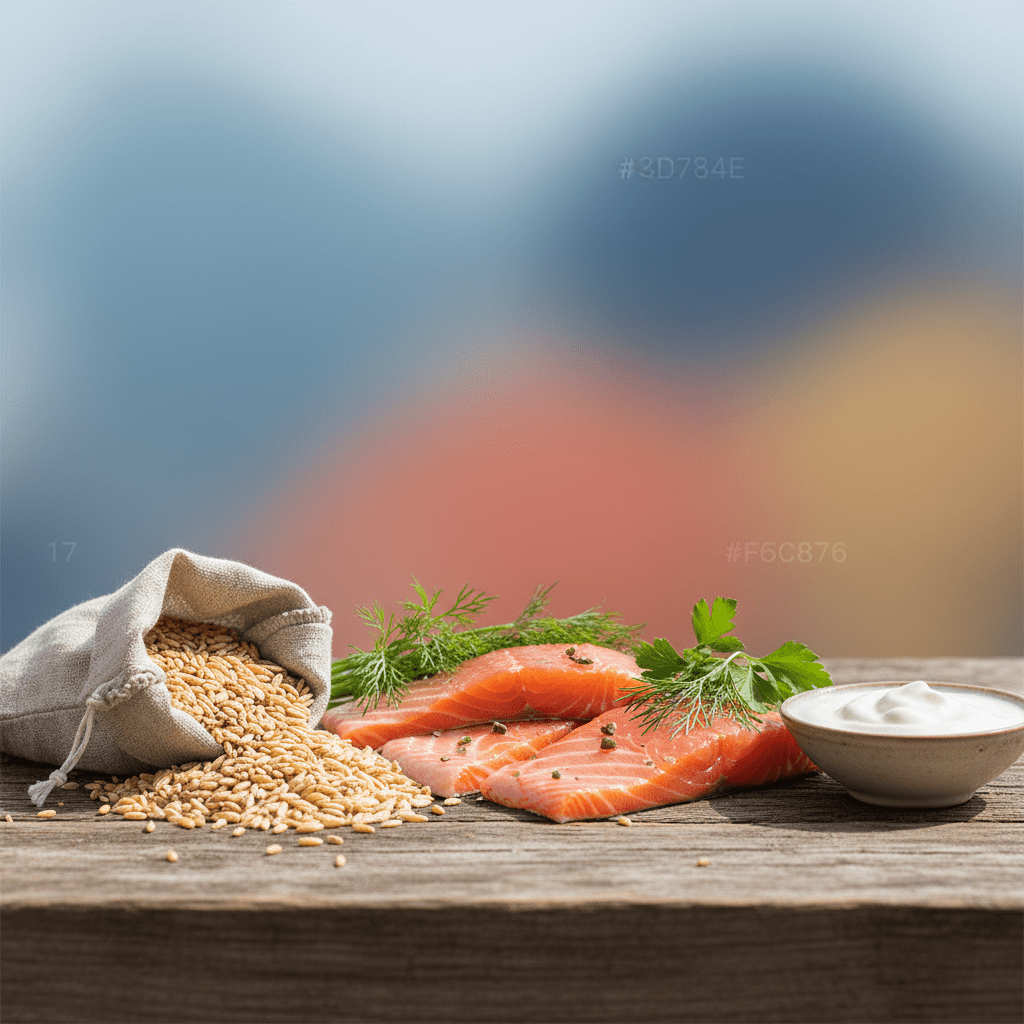Key Takeaways
- The best natural dog food focuses on ingredients that a dog's body can recognize and digest.
- Commercial kibble often contains synthetic preservatives that can cause digestive issues in dogs.
- Switching to natural dog food with whole food ingredients can improve a dog's energy and coat health.
- Choosing natural dog food requires looking beyond marketing claims to the actual ingredient quality.
Table of Contents
- Why Natural Nutrition Matters for Our Pets
- What is Natural Dog Food?
- Why Choose Natural Dog Food?
- How to Read a Natural Dog Food Label
- Top Natural Dog Food Picks for 2025
- How to Safely Transition Your Dog to Natural Food
- Homemade Natural Dog Food: Is It Right for You?
- Natural vs. Conventional Dog Food: The Real Differences
- Common Challenges and Practical Solutions
Why Natural Nutrition Matters for Our Pets
When my Border Collie mix Tango started struggling with digestive issues from commercial kibble loaded with synthetic preservatives, I learned that what is the best natural dog food isn't just about marketing claims, it's about ingredients your dog's body actually recognizes. After switching to natural options with whole food ingredients, Tango's energy returned and his coat regained its shine within weeks.
Natural dog food represents more than a trend; it's a return to feeding our pets the way nature intended. Unlike conventional kibble packed with artificial colors, flavors, and chemical preservatives, natural formulas rely on recognizable ingredients from plants, animals, and minerals. This approach supports your dog's digestive system, reduces allergic reactions, and often leads to improved vitality that pet parents notice within days.
If your dog struggles with issues like itching, shedding, or dandruff, consider trying our Dog Allergy Relief & Immune Support to support their skin and coat health alongside a natural diet.
Natural dog food contains ingredients sourced from plants, animals, and minerals without artificial flavors, colors, or synthetic preservatives. Look for AAFCO-compliant formulas with named proteins (like "chicken" not "poultry meal") and recognizable whole food ingredients you could pronounce to a five-year-old.
What is Natural Dog Food?

Natural dog food follows strict ingredient sourcing guidelines, using only components derived from plant, animal, and mineral sources. The Association of American Feed Control Officials (AAFCO) defines "natural" as ingredients that haven't been chemically synthesized, though minimal processing for safety and nutritional adequacy is permitted.
The key distinction lies in what's excluded: no artificial flavors, synthetic colors, or chemical preservatives like BHA, BHT, or ethoxyquin. Instead, natural formulas use vitamin E (mixed tocopherols) or vitamin C (ascorbic acid) to maintain freshness. Processing methods also matter, gentle cooking techniques preserve more nutrients compared to high-heat extrusion used in conventional kibble manufacturing.
Understanding label terminology helps you make informed choices. "Natural" means ingredients from nature with minimal processing. "Organic" requires USDA certification with stricter farming standards and no synthetic pesticides. "Human-grade" indicates ingredients meet FDA standards for human consumption, representing the highest quality tier available.
| Standard | Ingredient Requirements | Processing Rules | Certification Needed |
|---|---|---|---|
| Natural | Plant, animal, mineral sources only | Minimal processing allowed | AAFCO compliance |
| Organic | 95% certified organic ingredients | No synthetic pesticides/fertilizers | USDA Organic seal |
| Human-Grade | FDA standards for human food | Human food facility manufacturing | FDA facility registration |
Why Choose Natural Dog Food?
Dogs fed natural diets consistently show measurable health improvements within 2-4 weeks of switching. A 2023 study published in the Journal of Animal Science found that dogs consuming natural formulas experienced 40% less digestive upset and 35% improvement in coat quality compared to those eating conventional kibble with synthetic additives.
Bailey, a Golden Retriever from our community, struggled with chronic itching and dull fur on conventional food. Within three weeks of switching to a natural salmon-based formula, his scratching decreased dramatically and his coat developed the healthy shine his family hadn't seen in years. These transformations happen because natural ingredients work with your dog's digestive system rather than against it. For more on how diet impacts small breeds, see what dog food is best for small dogs.
Beyond individual health benefits, choosing natural dog food supports environmental sustainability. Natural food companies typically source from farms using regenerative agriculture practices, reducing chemical runoff and supporting biodiversity. Many also use recyclable packaging and carbon-neutral shipping methods, making your pet's meals an investment in planetary health.
Common improvements pet parents report: Increased energy levels, better breath, firmer stools, reduced shedding, clearer eyes, and decreased food-related allergic reactions. Most dogs show initial improvements within 10-14 days of transitioning to natural nutrition.
How to Read a Natural Dog Food Label
The ingredient list tells the real story of any natural dog food. Ingredients appear in descending order by weight, so the first five items make up the majority of your dog's meal. Look for named proteins like "deboned chicken" or "salmon meal" rather than vague terms like "meat by-products" or "animal digest."
Avoid ingredients you can't pronounce or wouldn't recognize in your own kitchen. Red flags include BHA, BHT, propylene glycol, artificial colors (like Blue #2 or Red #40), and generic "natural flavors" without source identification. Quality natural foods specify their flavor sources, such as "natural chicken flavor" or "natural sweet potato flavor."
The Guaranteed Analysis panel shows minimum protein and fat percentages, plus maximum fiber and moisture content. For most adult dogs, look for at least 18% protein and 5% fat, though active breeds need higher levels. Senior dogs often benefit from moderate protein (around 20-25%) to support kidney health while maintaining muscle mass.
Understanding feeding guidelines prevents overfeeding, a common issue when switching from nutrient-sparse conventional foods to nutrient-dense natural formulas. Most dogs need 20-30% less food per meal compared to lower-quality alternatives. A 50-pound dog might thrive on 2-3 cups of premium natural food versus 4-5 cups of conventional kibble.
Top Natural Dog Food Picks for 2025

After analyzing ingredient transparency, sourcing practices, and real-world results from our community, these brands consistently deliver on their natural promises. We've prioritized companies that share their complete supply chain and avoid synthetic preservatives entirely.
| Brand | Primary Protein | Processing Method | Preservatives | Best For |
|---|---|---|---|---|
| Other leading brands | Fresh regional meats | Low-temperature | Natural only | Active dogs |
| Another popular brand | Humanely raised | Gentle cooking | Mixed tocopherols | Ethical families |
| Alternative solutions | Real meat first | Traditional kibble | Natural blend | Budget-conscious |
| Other popular brands | Limited ingredient | Controlled process | Vitamin E | Sensitive stomachs |
High-Protein Biologically Appropriate Options
Best for: High-energy dogs and owners seeking maximum protein density
Many premium brands follow a "whole prey" philosophy that mirrors what dogs would eat in nature, muscle meat, organs, and cartilage from regional farms. Their 85% animal ingredients create nutrient profiles that support lean muscle development and sustained energy. Dogs typically show improved coat shine within three weeks of consistent feeding. If your dog is experiencing issues like shedding or dandruff, pairing a natural diet with targeted supplements, such as our Dog Allergy Relief & Immune Support, can further enhance coat health.
Ethical Transparency Leaders
Best for: Families prioritizing humane farming and environmental responsibility
Some brands offer "traceable to farm" approaches that let you scan QR codes to see exactly where each ingredient originated. Their humanely raised proteins and non-GMO vegetables appeal to environmentally conscious pet parents. The gentle cooking process preserves more vitamins than high-heat extrusion methods.
Accessible Quality Choices
Best for: Multi-pet households needing reliable nutrition without premium pricing
Alternative solutions prove natural doesn't require breaking the bank. Real meat leads their ingredient lists, supported by wholesome grains and vegetables. Their consistent quality control and wide availability make transitioning easy, while probiotics support digestive health during dietary changes.
Limited Ingredient Specialists
Best for: Dogs with food sensitivities or allergies
Some brands' L.I.D. formulas contain just one animal protein and one carbohydrate source, making allergen identification simple. Their decades of experience with elimination diets helps veterinarians recommend specific formulas for dogs with complex dietary restrictions.
How to Safely Transition Your Dog to Natural Food
Gradual transitions prevent digestive upset while allowing your dog's gut bacteria to adapt to richer nutrition. Most dogs need 7-10 days for complete dietary changes, though sensitive stomachs may require two weeks.
Days 1-3: Mix 25% new food with 75% current food. Monitor for loose stools or decreased appetite, both indicate you're moving too quickly. Days 4-6: Increase to 50/50 ratio if no digestive issues appear. Days 7-10: Gradually shift to 75% new food, then 100% by day 10.
Watch for positive changes during transition: increased water consumption often signals better protein absorption, while firmer stools indicate improved digestibility. Energy levels typically stabilize within the first week, followed by coat improvements in weeks 2-3.
Red Flag Signs: Persistent vomiting, bloody diarrhea, or complete food refusal for 24+ hours requires veterinary consultation. Normal transition symptoms include mild gas or slightly softer stools for 2-3 days.
Keep detailed feeding notes during transitions, especially for dogs with known sensitivities. Record meal times, portion sizes, and any behavioral changes, this information proves invaluable if adjustments become necessary or if you're working with a veterinary nutritionist.
Homemade Natural Dog Food: Is It Right for You?
Homemade natural dog food offers complete ingredient control but requires significant nutritional knowledge to avoid deficiencies. Successful home cooking means understanding that dogs need different ratios of nutrients than humans, particularly calcium, phosphorus, and essential fatty acids.
A balanced homemade meal contains approximately 50% high-quality protein (muscle meat, organs), 25% complex carbohydrates (sweet potatoes, brown rice), and 25% vegetables (carrots, spinach, broccoli). Add healthy fats like fish oil for omega-3s, but avoid cooking oils that break down under heat.
Time commitment often surprises new home-cooking enthusiasts. Weekly meal preparation for a medium-sized dog requires 3-4 hours of shopping, cooking, and portioning. Cost analysis shows homemade meals typically run $3-5 per day for a 50-pound dog, comparable to premium commercial natural foods but requiring significantly more effort.
Consult with a veterinary nutritionist before starting homemade feeding, especially for puppies, senior dogs, or pets with health conditions. They can provide recipes that meet AAFCO nutritional standards and recommend appropriate supplements to prevent deficiencies.
Natural vs. Conventional Dog Food: The Real Differences

The ingredient gap between natural and conventional dog food reveals itself immediately on the label. Natural foods list recognizable proteins like "deboned chicken" or "salmon meal," while conventional options often feature "meat by-products" or "poultry meal", terms that can include anything from organ meat to feathers. For more on the differences between pet foods, see what's the difference between dog and cat food.
| Factor | Natural Dog Food | Conventional Dog Food |
|---|---|---|
| Primary Proteins | Named meats, fish, identifiable sources | Meat by-products, unnamed meal sources |
| Preservatives | Vitamin E (tocopherols), vitamin C | BHA, BHT, ethoxyquin |
| Fillers | Whole grains, vegetables, fruits | Corn gluten, wheat middlings, soy |
| Colors/Flavors | None or natural sources only | Artificial dyes, chemical flavor enhancers |
| Price Range | $2-4 per pound | $0.50-1.50 per pound |
| Digestibility | Higher protein absorption rates | Variable, often lower bioavailability |
Processing methods create the most significant difference. Natural foods typically use gentler cooking temperatures that preserve more nutrients, while conventional manufacturing often involves high-heat extrusion that can destroy vitamins and alter protein structures.
The cost difference reflects ingredient quality and sourcing standards. Natural food companies often pay premium prices for human-grade meats and organic vegetables, while conventional brands optimize for lowest-cost ingredients that meet minimum nutritional requirements. For more information on selecting a good commercial pet food, visit selecting a good commercial pet food.
Long-term health impacts show up in veterinary bills. Dogs eating natural diets typically experience fewer skin allergies, digestive issues, and inflammatory conditions, though genetics and overall care play equally important roles in health outcomes.
Common Challenges and Practical Solutions
Digestive upset during the first week affects about 30% of dogs switching to natural food. This usually indicates the transition happened too quickly, not that natural food is inappropriate. Slow down the process, offering smaller, more frequent meals until their system adjusts.
Food refusal often stems from texture differences rather than taste. Dogs accustomed to heavily flavored conventional foods might find natural options bland initially. Add a tablespoon of warm water or low-sodium bone broth to enhance palatability without compromising nutritional integrity.
Price concerns rank among the top hesitations for natural food adoption. Calculate cost per serving rather than per bag, nutrient-dense natural foods often require smaller portions, making the actual feeding cost more comparable to conventional options than initial sticker prices suggest.
Storage challenges arise because natural foods lack synthetic preservatives. Keep opened bags in airtight containers in cool, dry locations. Purchase smaller bags more frequently rather than bulk buying, and always check expiration dates before feeding.
If your dog continues experiencing digestive sensitivities even after transitioning to natural food, consider adding our Dog Allergy Relief & Immune Support to help support their digestive balance and overall comfort.
Not a substitute for professional veterinary advice.
Frequently Asked Questions
What are the main differences between natural dog food and conventional commercial kibble?
Natural dog food uses recognizable, whole food ingredients without artificial flavors, colors, or synthetic preservatives, while conventional kibble often contains chemical additives and less transparent protein sources. Natural formulas support digestion and overall vitality by focusing on ingredients your dog's body can easily process.
How can I identify truly natural dog food by reading the ingredient labels?
Look for named proteins like "chicken" instead of vague terms like "poultry meal," and avoid artificial colors, flavors, or synthetic preservatives. Ingredients should be simple, pronounceable, and free from chemical additives, with natural preservatives like vitamin E or C used to maintain freshness.
What benefits can I expect when switching my dog to a natural diet?
Switching to natural dog food may improve your dog’s energy levels, coat shine, and digestive comfort. Many pet parents notice reduced itching, shedding, and overall better vitality as their dog’s body responds well to whole food ingredients.
Is homemade natural dog food a good option, and what should I consider before making the switch?
Homemade natural dog food can be a great way to control ingredients and tailor nutrition, but it requires careful planning to ensure balanced meals. Consult your vet or a pet nutrition expert to avoid nutritional gaps and make the transition safely.



